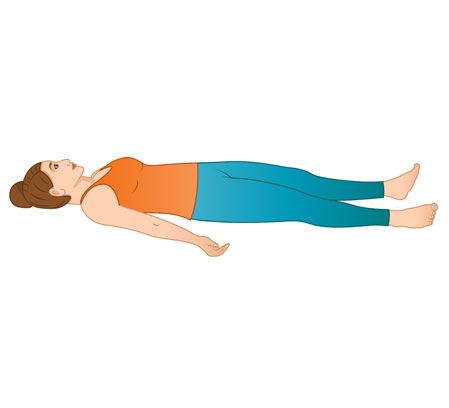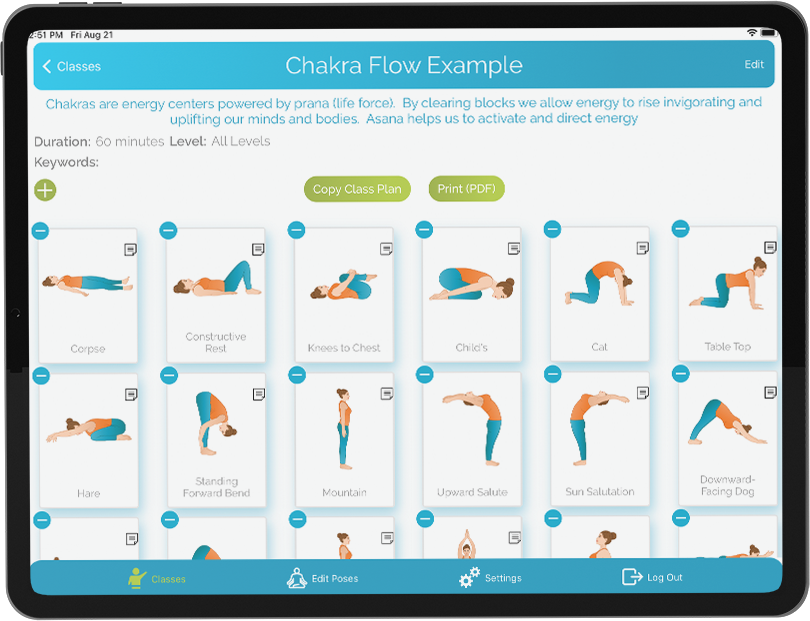Corpse Pose
Savasana

STEPS
Come to lie on the back with the legs open and the arms releasing at the sides. Carefully lift the pelvis slightly to tuck the tailbone down. For those with tight hip flexors or hyper-lordosis, placing a bolster under the knees will help to make this adjustment. Next, rock the upper body slightly to allow the shoulders blades to tuck in and down, releasing the front of the chest. In doing this the arms should relax to the appropriate distance at the sides of the body. Turn the palms up. Lengthen through the back of the neck, relaxing the back of the head into the ground beneath you. Some students may need a pillow behind the head to allow the neck to release.
Begin to scan the body for gripping and tension. Allow tension to melt from the body, releasing the jaw, the inner ears, the nose. Relax the eyes and forehead, allowing the eyes to sink to the back of the head. Release control of the breath. Allow the breath to breathe you.
It is recommended that for every half hour of Asana practice, 5 minutes of Savasana is allotted. This may also vary depending on the intensity of the class and the attention span of the students. It is very important not to skip this posture.
To come out, first, softly waken up the body. Deepen the breath and begin to bring life to the limbs. Roll over to the right side of the body (to avoid putting pressure on the heart). Take a few breaths here. When you are ready, use the top arm to press yourself up.
TEACHER QUEUES
VISUALIZATION COMMENTS
There are many approaches as a teacher for guiding Savasana. Often I have heard teachers guide their students through relaxing and releasing each part of the body, much like Yoga Nidra. I have had other teachers sing, play music, or read poetry, to encourage students to go beyond the physicality of their body and move into a deepened state of consciousness. The most important thing to remember as a teacher is that you are holding the energy for your students to feel safe and to completely let go. Keep an eye on your students and look for signs that they have released before guiding them back into the room.
TECHNICAL COMMENTS
Before moving into Savasana, prepare the body by removing glasses, loosening tight ponytails and removing jewelry. Make sure the body stays warm. Put on socks, sweaters, or use a blanket. The body temperature will drop as the breath rate slows. Eye pillows will also help to relax the muscles surrounding the eyes and nose.
If you choose to make physical adjustments during Savasana be sure to ask permission before hand and also warn students that you are going to do so. Make sure any adjustment you give is purposeful and helpful to the pose. Gently pressing on the shoulders to open the chest feels great, as does a slight lift of the head to lengthen and release the neck. If you’re not sure as a teacher, don’t do it. This is a time for students to feel safe and supported, not confused by misdirected intentions. Practicing on friends is great way to find out what works and what doesn’t.
BENEFIT COMMENTS
- Stress release and deep relaxation.
- Calms the nervous system.
- Beneficial for insomnia, headaches, pain relief.
- Helps to lower high blood pressure.
WATCH OUT FOR
- Popping ribcage.
- Shoulders in the ears.
- Lifting too high and losing congruety of the spine- too much lower back.
- Legs popping off.
- Lifting the head too high.
- Shoulders in the ears.
- Heels lifting
CONTRAINDICATIONS
- Pregnancy: Elevate the head and chest using cushions and bolsters. Conversely, Savasana could be done side-lying.
- Back Injury: Bend the knees to place the feet flat on the floor. If it’s comfortable allow the legs to tip together.
MODIFICATIONS
Lift the hands, only come up to a place where you can support your spine without pushing. Cobra Push Up: Extend the arms in front of the body, slightly wider than the shoulders. As you inhale, slide the palms along the floor to lift the chest. On the exhalation, allow the palms to slide forward releasing back onto the chest.
VARIATIONS
- Lying on side
- Lying on stomach
YOGA COUNTER POSES
This posture should be practiced at the end of each Asana practice.
Written By: Meghan Aris
Certified in several disciplines of yoga, a pilates teacher and teacher trainer, Meghan is continually widening her path of body/mind studies. At a young age she began her journey into body movement through dance. After being diagnosed with Rheumatoid Arthritis, she shifted her practice to more rehabilitative yoga. In this discipline she found not only the resources to heal her body, but also a guide to living a life full of peace and joy. She can be found teaching on any given day at The Space Vancouver.



